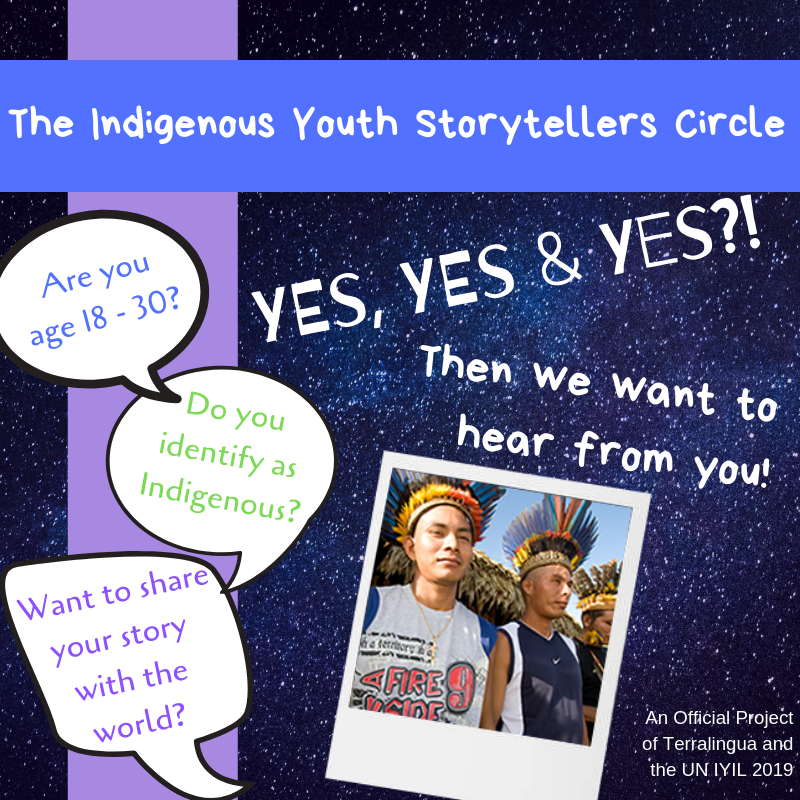
Indigenous Youth Storytellers Circle
February 18, 2019 12:00 am - December 31, 2019 12:00 am
Global | Canada | Salt Spring Island | Online and in print
Media
The Indigenous Youth Storytellers Circle: Share Your Story with the World!
An Invitation to Young Indigenous People
All across the world, young Indigenous people like you are taking the lead in showing ways to live respectfully on Earth. Your languages, your cultures, and your homelands bear the wisdom of generations of ancestors and of your community now — and they have helped make you who you are today. Your people’s wisdom and your own personal experiences are priceless gifts full of much-needed inspiration for the rest of the world.
We at Terralingua — the world’s leading nonprofit organization devoted to promoting and protecting biocultural diversity — believe that a great way to share these gifts is through personal stories of how young Indigenous people are connecting with their ancestral languages, cultural traditions, and land-based knowledge and practices. That is why we have created the Indigenous Youth Storytellers Circle, a global online gathering of those stories — and we invite you to be a part of it!
The Indigenous Youth Storytellers Circle is a year-long project linked to Terralingua’s flagship publication, Langscape Magazine . We aim to collect and publish personal stories from people who are involved with:
• reaffirming cultural identity;
• breathing new life into their ancestral languages;
• reconnecting with traditional knowledge and practices,
values, and ways of life; and
• reclaiming ancestral links with the land.
The Indigenous Youth Storytellers Circle is recognized as an official project of the United Nations’ International Year of Indigenous Languages, so your story has the potential to reach a global audience.
Here are a few examples of Indigenous Youth Stories we’ve already published in Langscape :
- Hellen Losapicho and Magella Hassan Lenatiyama use participatory video to document community issues and work closely with El Molo youth.
- Abraham Ofori-Henaku , a young Akan man from Ghana, tells his story about his “missing tongue,” Twi.
- Rohahiyo Jordan Brant tells the story of becoming a learner and then a teacher of Kanyen’kéha (Mohawk Language).
- Somnath Dadas , a young Dhangar (shepherd) man, tells the story of chasing dreams of higher education in Mumbai, India, and returning to his pastoralist roots in Kothale village.
- Lina Karolin , from the Ot Danum community in Indonesia, writes about how her family’s preparation of a special form of rice each year was an important part of how she viewed herself as a young Indigenous woman growing up.
- Joe Akerman , of Quw’utsun (Coast Salish) descent, comes home — literally and metaphorically — to the village site of his ancestors on the west coast of Canada, as a sacred space to heal the land and people’s relationships with one another.
- Manju Maharjan of Nepal’s Newar community explains how helping make a traditional type of salad with roasted meat, a dish reserved for special occasions, is an important part of her people’s cultural identity.
If you are a young Indigenous person and would like to tell about your experiences connecting to your ancestral languages, cultures, and lands, we want to hear from you!
Interested? Here’s How You Can Submit Your Story to the Indigenous Youth Storytellers Circle!
- Read about the formats your contribution can take.
- Fill out the form on our website . (Some stories are created by several youth; choose one person to fill out the form.)
- We’ll send you instructions for sending your story, depending on its format.
Formats:
• Writing (essay, poem, short fiction, song lyrics, a
podcast script, etc.; up to 2,000 words)
• Photography (photoessay with up to 10 pictures, each
with a descriptive caption that, altogether, tell a
story)
• Video (up to 5 minutes long)
• Audio recording, spoken story (up to 5 minutes long)
• Audio recording, music (original songs or other music;
up to 5 minutes long)
• Digital representations of painting, drawing, or other
visual art
• Multimedia: a complementary combination of formats
Email questions to Coreen, our Editorial Assistant .
How will stories be chosen?
The editors of Langscape will review each contribution received to make sure it addresses the goal of sharing stories of Indigenous Youths’ cultural renewal.
What’s most important is that your contribution be personal and genuine; it does not have to be “perfect” or look like it was done by a professional with lots of experience. We want people who read, look at, or listen to your story to get a strong sense of you as a young Indigenous person.
How will my story be published?
All accepted Indigenous Youth Stories will be published on our web pages. In addition, a selection of stories will also be published in Langscape Magazine , which in 2019 will be devoted entirely to Indigenous Youth Stories. Stories selected for Langscape will appear in both the digital and print editions of the magazine and will receive a small award as a token of appreciation.
Indigenous Youth Stories will be published in English, but can also be submitted in French or Spanish — we’ll translate them into English. Although our audience is English-speaking, we invite you to be creative in how you educate our audience about your Indigenous language and culture in your story.
Deadlines
Our final deadline has passed.
